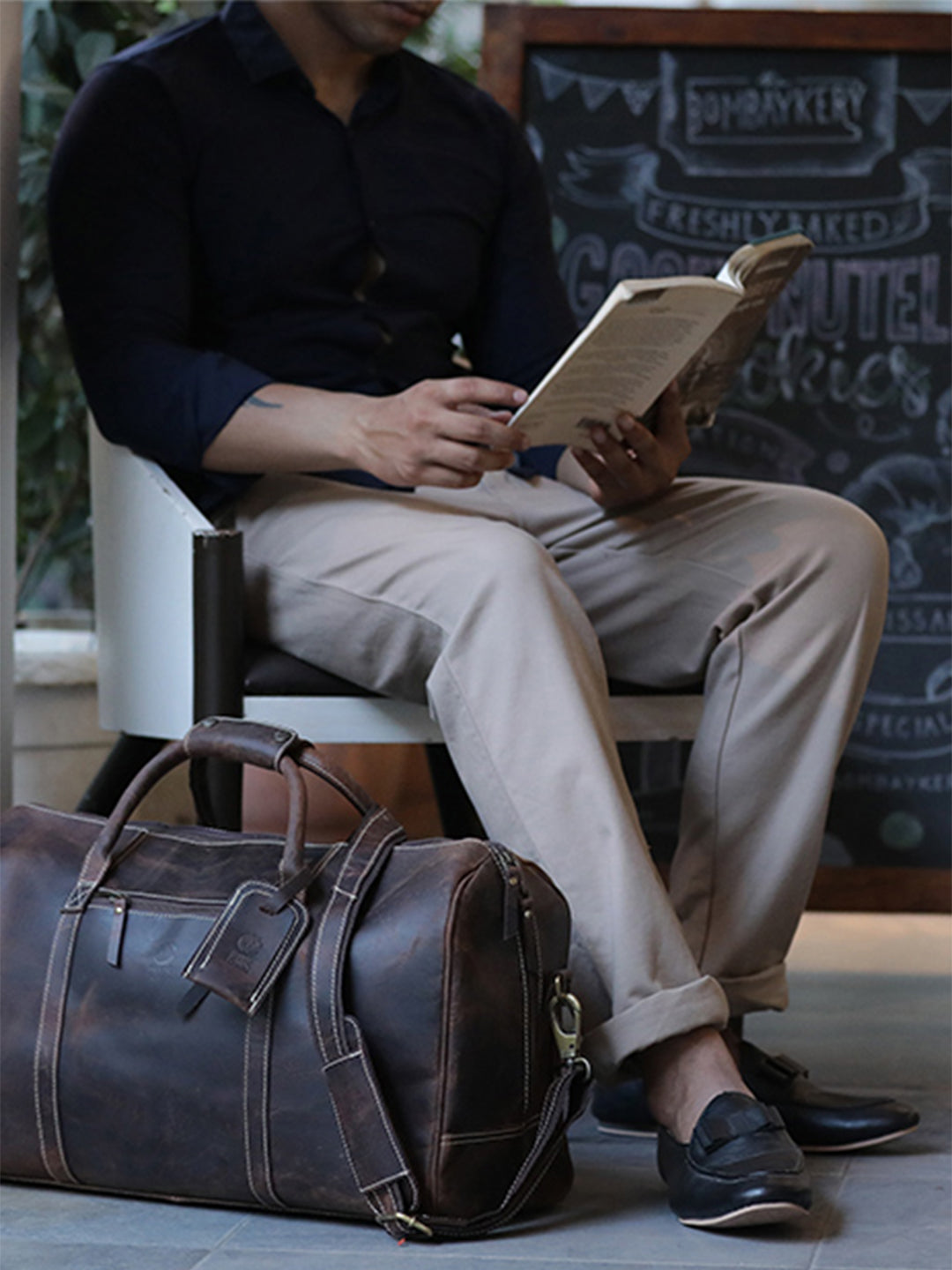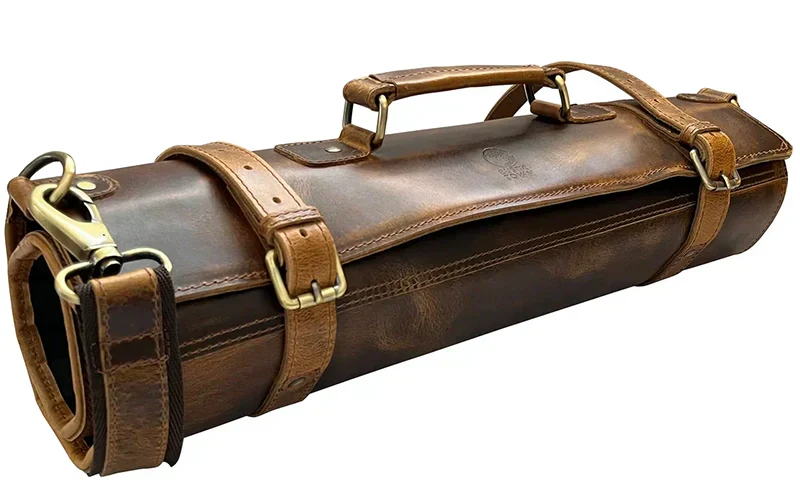Introduction to Leather Journals
Leather Journals:
the epitome of sophistication, the embodiment of timeless elegance. There's something undeniably alluring about the tactile experience of flipping through the pages of a beautifully crafted leather-bound book. In today's digital age, where screens dominate our daily lives, the resurgence of analog practices like journaling is nothing short of remarkable.
But what exactly makes leather notebook journal so special? Why do people choose them over their digital counterparts? Let's delve into the captivating world of leather journals and uncover the myriad of reasons why they continue to capture the hearts of writers, artists, and dreamers alike.
Understanding the Allure of Leather Journals
Imagine running your fingers over the smooth, supple surface of a fine leather journal. The scent of genuine leather wafting through the air, transporting you to a bygone era of craftsmanship and tradition. There's a sense of nostalgia that permeates every page, inviting you to slow down, to savor each moment as you put pen to paper.
Unlike typing on a keyboard or tapping on a touchscreen, writing in a leather journal is a tactile experience. It engages your senses in a way that digital devices simply can't replicate. There's a visceral connection between hand and paper, a sense of intimacy that fosters creativity and self-expression.
Benefits of Using Leather Journals Over Digital Alternatives
In a world inundated with digital distractions, leather journals offer a sanctuary of focus and concentration. With no notifications to interrupt your thoughts, you're free to explore your ideas without the constant pull of technology. Plus, studies have shown that writing by hand can enhance memory retention and cognitive processing, making leather journals not just a tool for creativity, but also for mental well-being.
But the benefits extend beyond the psychological realm. Leather journals are durable, able to withstand the test of time in a way that digital files cannot. They age gracefully, developing a patina that tells the story of their journey alongside you. And unlike digital notes that can easily be lost or corrupted, the contents of a leather journal are tangible, a tangible record of your thoughts and experiences.
Choosing the Right Leather Journal
Now that we've explored the allure of leather journals, let's dive into the nitty-gritty of choosing the perfect one for you. With so many options on the market, ranging from vintage-inspired classics to modern minimalist designs, finding the right leather journal can feel like a daunting task. But fear not, dear reader, for we're here to guide you through the process.
Factors to Consider When Selecting a Leather Journal
When choosing a leather journal, it's essential to consider factors such as size, style, and functionality. Are you looking for a compact journal to carry with you on the go, or do you prefer a larger format for more extensive writing sessions? Do you prefer a rustic, distressed look, or are you drawn to sleek, minimalist designs? By clarifying your preferences upfront, you can narrow down your options and find the perfect journal that suits your needs and personality.
Different Types of Leather and Their Characteristics
Not all leather is created equal. From full-grain to top-grain to genuine leather, each type has its own unique characteristics and qualities. Full-grain leather, prized for its durability and natural beauty, is the gold standard for leather journals. It develops a rich patina over time, becoming softer and more supple with age. Top-grain leather, while slightly less rugged than full-grain, offers a balance of durability and affordability, making it a popular choice for everyday use. Genuine leather, on the other hand, is the lowest quality and often lacks the durability and aesthetic appeal of higher-grade leathers.
Features to Look For
Now that you have a better understanding of the different types of leather, let's explore the key features to look for when choosing a leather journal.
Quality of Leather
First and foremost, pay close attention to the quality of the leather. Look for journals made from full-grain or top-grain leather, as these are the most durable and long-lasting options. Avoid journals made from genuine leather, as they tend to degrade quickly and lack the luxurious feel of higher-quality leathers.
Binding Options
The binding of a leather journal plays a crucial role in its durability and functionality. Opt for journals with sturdy bindings, such as hand-sewn or glued bindings, that can withstand frequent use without falling apart. If possible, look for journals with lay-flat bindings, which make writing and sketching more comfortable by allowing the pages to lie completely flat.
Paper Quality and Thickness
The quality of the paper is another essential factor to consider when choosing a leather journal. Look for journals with thick, acid-free paper that can handle a variety of media, from fountain pens to watercolors. Avoid journals with thin, flimsy paper that may bleed or feather with heavy use.
Customization Options
One of the unique advantages of leather diary is the ability to customize them to reflect your personality and style. Whether you prefer a simple monogram or elaborate hand-tooled designs, there are endless customization options available to make your journal truly one-of-a-kind.
Personalization Services Offered by Manufacturers
Many manufacturers offer personalization services, allowing you to add your name, initials, or custom artwork to your journal. This is a great option if you're looking for a quick and easy way to personalize your journal writing without any DIY effort.
DIY Customization Ideas
If you're feeling crafty, why not try your hand at DIY customization? From hand-stitching to leather embossing to painting, there are countless ways to add a personal touch to your writing journal for men. Not only is DIY customization fun and rewarding, but it also allows you to create a journal that is truly unique to you.
Caring for Your Leather Journal
Once you've chosen the perfect leather journal and customized it to your heart's content, it's essential to take proper care of it to ensure its longevity. Leather is a natural material that requires regular maintenance to keep it looking its best. Here are some tips for caring for your leather journal:
Proper Maintenance Tips to Prolong Its Lifespan
-
Keep your journal away from direct sunlight and moisture, as these can cause the leather to dry out and crack.
-
Avoid placing heavy objects on top of your journal, as this can deform the cover and damage the binding.
-
Periodically condition your writing journal with a leather conditioner to keep it soft and supple.
-
If your journal gets dirty, gently clean it with a damp cloth and mild soap, then pat dry with a clean towel.
-
Store your journal book in a cool, dry place when not in use to protect it from dust and dirt.
Dealing with Common Issues Like Stains and Scratches
Despite your best efforts, accidents happen, and your journal book may end up with stains or scratches. Don't panic! With the right care and attention, you can easily restore your journal book to its former glory. For stains, try using a leather cleaner or saddle soap to gently remove the stain without damaging the leather. For scratches, rub a small amount of leather conditioner into the affected area to help disguise the scratch and blend it with the surrounding leather.
Creative Ways to Use Your Leather Journal
Now that you've learned how to choose and care for your leather journal let's explore some creative ways to use it.
Journaling Prompts and Ideas
Feeling stuck in a creative rut? Not sure what to write about? Try using journaling prompts to spark your imagination and get the words flowing. From thought-provoking questions to creative journal writing exercises, there are endless prompts available to help you explore new ideas and perspectives.
Artistic Uses Such as Sketching and Watercolor Painting
Leather journals aren't just for journal writing—they're also a blank canvas for artistic expression. Whether you're an aspiring artist or just enjoy doodling, a leather journal provides the perfect space to unleash your creativity. Try experimenting with different mediums, from pen and ink to watercolor paint, and let your imagination run wild.
Traveling with Your Leather Journal
For many people, travel is a time of adventure, discovery, and self-reflection. And what better companion for your travels than a trusty leather journal? Here are some tips for traveling with your writing journal:
Tips for Keeping Your Journal Safe While on the Go
-
Invest in a durable travel case or sleeve to protect your journal from bumps and scratches while in transit.
-
Use a sturdy closure, such as a leather strap or elastic band, to keep your journal securely closed when not in use.
-
Consider making digital backups of your leather bound journal entries to safeguard against loss or theft.
-
Be mindful of where you store your journal for men while traveling, keeping it close to you at all times to minimize the risk of loss or theft.
Documenting Your Adventures Effectively
Your travel journal is more than just a record of your journey—it's a treasure trove of memories and experiences that you'll cherish for years to come. To make the most of your travel journal, try incorporating photos, ticket stubs, and other mementos into your entries. Write about the sights, sounds, and sensations of your travels, capturing the essence of each destination in vivid detail.
Preserving Memories
As the saying goes, "memories fade, but words endure." Your leather notebook is a priceless keepsake, a tangible record of your thoughts, dreams, and experiences. Here are some tips for preserving your memories in your journal:
Using Your Journal as a Keepsake for Important Events
Whether it's a wedding, a birth, or a milestone birthday, your leather journal is the perfect place to capture the significance of life's special moments. Write about your thoughts and emotions leading up to the event, document the details of the day itself, and reflect on how it has impacted your life.
Incorporating Memorabilia into Your Journaling Practice
Don't limit yourself to words—incorporate memorabilia into your journaling practice to bring your entries to life. From ticket stubs to pressed flowers to handwritten notes, these little mementos add depth and richness to your leather journal, transforming it into a treasure trove of memories.
Historical Significance of Leather Journals
Leather journals have a rich history that spans centuries, tracing their origins back to the dawn of civilization. Let's take a journey through time and explore the historical significance of leather bound journal book.
Tracing the Origins of Leather-Bound Books
The practice of binding books in leather dates back to ancient civilizations such as the Egyptians, Greeks, and Romans, who used leather to protect and preserve their writings. In the Middle Ages, monks painstakingly copied and bound manuscripts by hand, creating beautifully illuminated works of art that are treasured to this day.
Cultural Significance and Symbolism of Leather Journals
Throughout history, leather has been prized for its durability, versatility, and beauty, making it the perfect material for bookbinding. Leather bound journals were often seen as status symbols, prized possessions passed down from generation to generation. Today, leather journals continue to evoke a sense of prestige and sophistication, symbolizing the timeless art of journal writing and storytelling.
Benefits of Analog Journaling
In today's fast-paced, digital world, the act of writing by hand has become somewhat of a lost art. But research shows that there are numerous psychological benefits to analog journaling that can't be replicated by typing on a keyboard or tapping on a touchscreen.
Psychological Advantages of Writing by Hand
Writing by hand engages different parts of the brain than typing, leading to improved cognitive function, memory retention, and emotional processing. It also allows for greater self-expression and creativity, as the act of physically writing slows down your thoughts and encourages deeper reflection.
Disconnecting from Screens and Digital Distractions
Analog journaling provides a welcome respite from the constant barrage of notifications and distractions that come with digital devices. By unplugging from screens and reconnecting with pen and paper, you can cultivate a sense of mindfulness and presence that is increasingly rare in our hyper-connected world.
Building a Journaling Routine
Now that you understand the benefits of analog journaling, it's time to establish a journaling notebook routine that works for you. Whether you prefer to write first thing in the morning, during your lunch break, or before bed, consistency is key to developing a journaling notebook habit that sticks.
Establishing a Consistent Habit of Journaling
Start by setting aside a specific time and place for journaling each day. Whether it's a cozy corner of your living room or a quiet spot in your favorite cafe, find a space where you feel comfortable and inspired to write. Then, commit to journaling for a set amount of time each day, whether it's five minutes or an hour. The important thing is to make journaling notebook a priority and stick to it, even on days when you don't feel like writing.
Overcoming Writer's Block and Staying Motivated
Writer's block is a common obstacle that can derail even the most dedicated journalers. But don't let it discourage you! Instead, try mixing things up by experimenting with different writing journal prompts, techniques, and mediums. You can also try free writing, where you write continuously for a set period of time without worrying about grammar or punctuation. The key is to keep writing, even if it feels difficult or uncomfortable at first. Remember, the more you practice, the easier it will become, and the more rewarding your journaling notebook experience will be.
Famous Writers and Their Leather Journals
Throughout history, leather journals have been the faithful companions of countless writers, poets, and thinkers, serving as silent witnesses to their creative journeys and innermost thoughts. From the humble notebooks of Leonardo da Vinci to the meticulously kept journals of Virginia Woolf, these leather-bound treasures offer a glimpse into the minds and methods of some of history's most beloved literary figures.
Take, for example, the legendary writer Ernest Hemingway, whose leather journals were as much a part of his persona as his iconic prose. From the battlefields of war-torn Europe to the sun-drenched streets of Havana, Hemingway's journals chronicled his adventures, insights, and insecurities with unflinching honesty and raw emotion. Hemingway believed that writing by hand allowed him to tap into his subconscious mind and access a deeper level of creativity than typing ever could. Today, these journals stand as a testament to his genius and a source of inspiration for aspiring writers the world over.
Other famous writers who swore by leather journals include Virginia Woolf, Mark Twain, and Anais Nin, each of whom had their own unique approach to journaling. Woolf used her journal as a space for introspection and self-analysis, while Twain used his to record his travels and adventures. Nin, on the other hand, used her journal as a form of therapy, exploring her thoughts and emotions in raw, unfiltered prose. Regardless of their individual methods, these writers all recognized the power of pen and paper to unleash their creativity and capture the essence of the human experience.
Incorporating Technology
In today's digital age, the line between analog and digital journaling is becoming increasingly blurred. Many journalers are turning to technology to enhance their journaling experience, whether it's through apps, gadgets, or digital tools.
Blending Analog Journaling with Digital Tools
One popular trend is the use of digital apps and platforms to supplement analog journaling practices. Apps like Evernote, Day One, and Penzu allow users to write, organize, and search their writing journal entries digitally, offering the convenience of digital storage with the tactile experience of analog writing. Some apps even offer features like voice-to-text transcription and photo integration, allowing users to capture their thoughts and memories in a variety of formats.
Apps and Gadgets to Enhance Your Journaling Experience
In addition to digital apps, there are also a variety of gadgets and accessories available to enhance your analog journaling experience. From smart pens that digitize your handwritten notes to electronic typewriters that mimic the feel of vintage typewriters, these tools offer the best of both worlds, combining the nostalgia of analog writing with the convenience of digital technology.
Conclusion
In conclusion, leather journals are more than just writing tools—they're portals to creativity, self-expression, and self-discovery. From their timeless elegance to their unparalleled versatility, leather journals continue to captivate and inspire writers, artists, and dreamers around the world. Whether you're documenting your travels, preserving precious memories, or simply jotting down your thoughts, a leather journal is the perfect companion for life's journey. So why wait? Pick up a leather journal today and start exploring the endless possibilities of analog journaling notebook.
FAQ's
-
How do I choose the right leather journal for my needs?
When selecting a leather journal, consider factors such as leather quality, binding style, and paper thickness. Choose a journal that not only appeals to your aesthetic preferences but also aligns with your intended usage, whether that be daily journaling, sketching, or something in between.
-
What is the best type of leather for a journal?
The best type of leather for a journal is full-grain or top-grain leather, as these are the most durable and long-lasting options. Genuine leather is lower quality and may degrade quickly over time.
-
What's the best way to care for a leather journal?
To prolong the lifespan of your leather journal, regularly clean it with a soft, damp cloth to remove dirt and dust. Avoid exposing it to moisture, sunlight, or extreme temperatures, and store it in a cool, dry place when not in use. If your journal sustains any stains or scratches, gently blot the affected area with a clean, damp cloth and consider using a leather conditioner or balm to restore its luster.
-
What is the benefit of analog journaling over digital journaling?
Analog journaling offers psychological benefits such as improved memory retention and cognitive processing, as well as a sense of mindfulness and presence that is often lacking in digital journaling. It also provides a break from screens and digital distractions, allowing for deeper reflection and self-expression.
-
How can I overcome writer's block and stay motivated to journal regularly?
Establishing a consistent journaling routine and creating a dedicated space for writing can help overcome writer's block and maintain motivation. Experiment with different journaling prompts and exercises to spark inspiration, and remember to be gentle with yourself on days when the words don't flow as easily.










